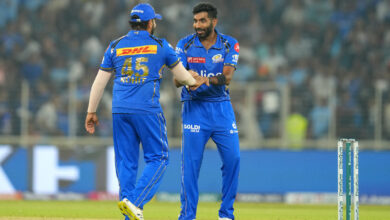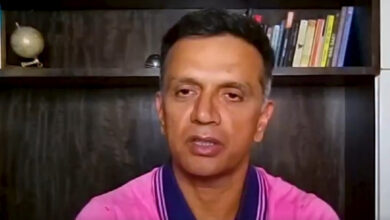World Cup 2023: Thrashing at the hands of South Africa shows Australia a shadow of great teams of the past | Cricket-world-cup News

A haunting quietness lingered in the dying moments of South Africa’s 134-run thrashing of Australia. Much of the audience had already emptied out of the elegantly-facaded stadium, those that remained were out of courtesy, the famous Lucknowi tehzeeb, and not out of hope of a dant Aussie miracle. Hollow faces peered from Australia’s dugout.It was a defeat dripped in symbolism. It had the feeling of an empire crumbling, perhaps unknown to the emperors themselves, like Premchand’s Shatranj ke Khiladi woven around the erstwhile nawabs of this city. In the short story, two nawabs are so engrossed in a game of chess that they are oblivious to the Britishers usurping their land. Similarly, no one saw Australia’s descent coming, not because the signs were not there, but because they chose to be blind, deluded their irresible hory.
Australia could yet enter the semifinals — bouncebackability is a fabled Aussie virtue — but there are dinct and siner signs of decay and disintegration.
There was a caginess about them even before their first game. There was not the usual swaggering confidence, replaced with a nervous wariness, a defensive bone squeezing into their DNA. It did not help that some of their important players were returning from injuries, in a year they were perceptibly fatigued two long and marquee series (the Border-Gavaskar Trophy, the Ashes); it did not ease their fortunes that some of their powerhouses are waning forces. David Warner is clearly not the force he once was; Mitchell Marsh has looked reckless; Steve Smith somehow dracted; Pat Cummins confused with his ODI methods, Mitchell Starc toothless without assance from the surface.
Simultaneously, the new generation of cricketers have not quite stepped up — the likes of Cameron Green, Marcus Stoinis and Josh Inglis — unlike in the past when players would relentlessly push for spots and fresh players sprouted from nowhere, staking their claims. So much of this team was forged in hope rather than conviction.
This was not the Australia generations grew up idolising. Far from it, a vague shadow of the past, drifting into the solemn dance. There is an even deadlier sign of things to come. The country that glamourised white-ball cricket, repackaged the game in coloured apparel, and gave floodlights, is no longer in love with the format as it once was.
Rather, like in a long marriage, boredom has crept in. It is a sign of the times, but depressing when the country that fully embraced it, is clutching at straws. Between World Cups, they played just 44 games (losing 20 of them). In comparison, India racked up 66 games in this span. There were other worrying numbers — this year they have lost the most number of wickets in the middle overs (5.67 a game); with the ball they have the second-worst strike rate between overs 11 and 40 (46.11).
Ever a collection of match-winning individuals, all their hopes of completing a he hinged on Smith’s shoulders. With his departure with the score on 50/3, Australia’s hopes faded into the dance.
Inept against pace and spin
As the outcome of the DRS review flashed on the screen, Smith was so startled that his eyes almost jumped out of his sockets. He stood still, agape, wondering whether it was a technical flaw. There was a sense of mild disbelief among the South Africans too, about to explode into celebration. Quinton de Kock, who cajoled Temba Bavuma into seeking the review, smiled impishly. Smith still lingered on, before walking away in dismay. His unhappiness was understandable, for even though Kagiso Rabada’s delivery had straightened, it didn’t seem like hitting the stumps to the naked eye, or even when watching the replays. But the ball-tracker showed it hitting the leg-stump. And one almost saw Australia’s heart wilt in the dressing room.
The wicket revved up Rabada, who produced an intimidating spell, where he hit an off-stump line and bent the ball either way. Josh Inglis, the wicketkeeper-batsman who replaced Alex Carey, perished to the classical double-bluff. Two balls landed on exactly the same spot, good length and on off-stump. The first cut into him; the second nipped away. Inglis was anticipating inward moment; he was undone away movement, as the ball snapped past his outside edge to hit the off-stump. Rabada struck a siner rhythm, and beat Glenn Maxwell’s repeated lunges. Australia’s methods in defusing spin have looked dodgy, but here they were ripped apart a pacer.
The South African speedster was a fearsome proposition, producing movement, bounce and aggression, giving elaborate send-offs to batsmen and celebrating with wild enthusiasm. There was an element of fortune with his third wicket, Marcus Stoinis caught down the leg-side, but it was the outcome of the relentless pressure he had exerted.Most Read
1
Australia vs South Africa Highlights, World Cup 2023: Kagiso Rabada scalps three as SA blow AUS 134 runs
2
Israel-Hamas War News Live Updates: Dropped 6,000 bombs on Gaza since start of war, says Israeli military; Blinken meets Netanyahu, assures US support
See More
Australia’s vulnerability against quality spin is well-chronicled, but they are expected to nullify pace and bounce more competently. They did not. Spin, too, would come to haunt them, on a surface that had none of the djinns they encountered in Chennai . The vastly- underrated Keshav Maharaj beat Maxwell with drift and dip, and induced a caught-and-bowled. Dip accounted for Marnus Labuschagne too to effectively end the game as a contest. In a blur, Australia’s World Cup-winning hopes lie tattered.
But the emblem of Australia’s stasis, their fall from grace, played out in South Africa’s innings, when they spilled ridiculously simple catches. They grassed four, none proving too expensive on its own. But it captures their ineptness, feebleness, the departure of that quintessential Australian trait of ruthlessness. Worse, those catches were dropped their wizened regulars — Adam Zampa (Bavuma), Cummins (Aiden Markram), Starc (David Miller) and Stoinis (Marco Jansen). Fielding is just one of the many malaises eating into them.
In the shambles of Lucknow, in the haunting quietness of Ekana, far from the nawabi ruins of the city, one could see the crumbling of a cricketing empire. The mightiest the sport had seen.







